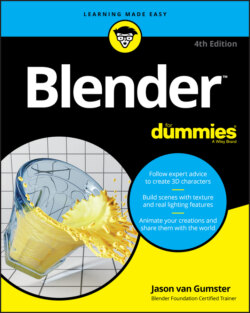Читать книгу Blender For Dummies - Jason van Gumster - Страница 79
Switching between Object mode and Edit mode
ОглавлениеIn Chapter 3, you do just about everything in Object mode. As its name indicates, Object mode is where you work with whole objects. However, Object mode isn’t very useful for actually changing the internal structure of your object. For example, select the cube in the default scene. You know that you can turn it into a more rectangular shape by scaling it along one of the axes. But what if you want to turn the cube into a pyramid? You need to modify the actual components that make up the cube. These changes are made by entering Edit mode.
There are a handful of different ways you can get to Edit mode. To get there by menu, left-click the Interaction Mode button in the 3D Viewport’s header. It should say Object Mode right now, because that’s the mode you’re currently in. From the drop-down menu that appears, select Edit Mode (see Figure 4-1). Be aware that if you’re working with an object other than a mesh, such as an armature, the contents of this menu may vary slightly to relate more to that object. However, with the exception of Empties (see Chapter 11), Lights, Cameras, and Speakers, all objects have an Edit mode.
Of course, Blender also has a hotkey to enter Edit mode. Actually, technically speaking, the hotkey toggles you between Object mode and Edit mode. Pressing Tab is the preferred way to switch between modes in Blender, and it’s used so frequently that Blender users often use Tab as a verb and say they’re tabbing into Edit mode or Object mode. This language is something you come across fairly often in Blender user forums and in some of Blender’s online documentation.
A slightly better approach, in my opinion, is to use pie menus. Press Ctrl+Tab to open a pie menu with the option of many modes. It isn’t quite as fast as toggling with Tab, but it can be pretty fast if you use the hold hotkey ⇒ drag mouse cursor ⇒ release hotkey method of using the pie menu. More importantly, you get the added benefit of easily choosing other modes. Figure 4-1 shows the Interaction Mode menu in the 3D Viewport’s header and the Mode pie menu.
FIGURE 4-1: On the left, the Mode button allows you to switch between Object mode and Edit mode for a selected object. On the right, the mode selection pie menu.
There’s another means of entering Edit mode that’s really quite handy: You can use Blender’s workspaces to your advantage. By default, Blender launches when you’re in the Layout workspace, which is a decent general purpose workspace that you can use to get a lot done. However, the Layout workspace isn’t specifically geared for modeling. If you switch to the Modeling workspace (click the Modeling tab at the top of the Blender window), Blender automatically toggles Edit mode for your selected objects.
As Figure 4-2 shows, the Modeling workspace doesn’t really look all that different from the Layout workspace. It’s basically the same area configuration, minus the Timeline at the bottom and with a little more space for the Properties editor. That said, there’s a lot of value in using the right workspace for the job. A good workflow would be to select the object you want to work on in the Layout workspace and then jump over to the Modeling workspace (you can get there by hotkey using Ctrl+PageDown) to edit the components of your model in Edit mode. And after you’re done, you can pop back over to the Layout workspace (Ctrl+PageUp) to pick another object to work on in Object mode.
